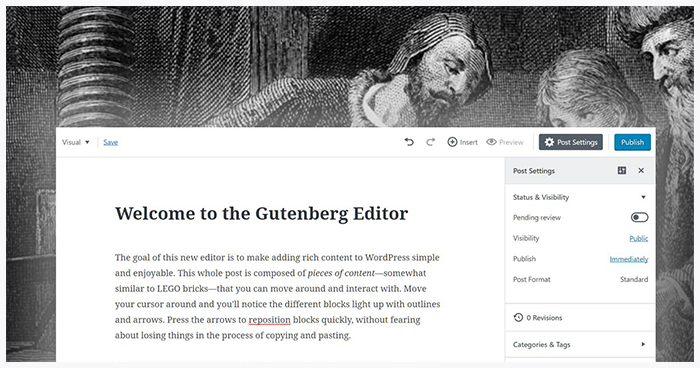WordPress is powering thousands of websites across the globe because of an easy to use interface. The simplicity of managing and updating a website is making the merchants, sellers, bloggers, and service providers develop or move their digital assets to the WordPress platform.
One of the striking features of WordPress is its classic text editor that requires users to simply compose, edit, and publish content without creating code for a page or post. The Gutenberg editor is about to replace this text editor to comply with the changing ways of presenting content and come up with an advanced publishing platform.
WordPress has continuously changed over the time with the introduction of attractive features and security improvements. But, the replacement of content editor will be one of the major moves since its inception. This post is going to discuss the Gutenberg editor in detail, why it will be made a default editor, and other important facts you need to know.
 As I have already mentioned that changing the basic writing tool in WordPress that is the text editor is a major change. Being a major breakthrough, Gutenberg has been a victim of criticism from the day it was announced. The large community of bloggers, publishers, and content creators are on-stack as how the change will affect their publishing and readership experience. The reason for the emotional distress is because most of the people are not sure of the need, purpose, and benefit of the plugin.
Gutenberg editor is a replacement of the text editor we currently use by default in the WordPress user interface. The default TinyMCE-based editor has a simple layout that sets the user to design it with custom code. But, Gutenberg is said to ensure a distraction-free reading interface. It will revamp the way webmasters are creating and publishing content.
The design will be more user-focused that’s why various options are either removed or replaced with better alternatives. The core addition to the editor will be built-in blocks that will be helpful in aiming a creative and appealing layout. This may sound similar to the available page builder platforms or plugin, but it has an advanced functionality in terms of usage.
As I have already mentioned that changing the basic writing tool in WordPress that is the text editor is a major change. Being a major breakthrough, Gutenberg has been a victim of criticism from the day it was announced. The large community of bloggers, publishers, and content creators are on-stack as how the change will affect their publishing and readership experience. The reason for the emotional distress is because most of the people are not sure of the need, purpose, and benefit of the plugin.
Gutenberg editor is a replacement of the text editor we currently use by default in the WordPress user interface. The default TinyMCE-based editor has a simple layout that sets the user to design it with custom code. But, Gutenberg is said to ensure a distraction-free reading interface. It will revamp the way webmasters are creating and publishing content.
The design will be more user-focused that’s why various options are either removed or replaced with better alternatives. The core addition to the editor will be built-in blocks that will be helpful in aiming a creative and appealing layout. This may sound similar to the available page builder platforms or plugin, but it has an advanced functionality in terms of usage.
 According to Expanded Ramblings, a business statistic website, WordPress is powering 27% of the global websites. So, it has grown into a massive community of WordPress web developers, coders, bloggers, authors, professionals, sellers, merchants, or lots of business enthusiasts. These all stakeholders have concerns about the development and application of Gutenberg editor. Here, I am sharing all that you need to know about it.
According to Expanded Ramblings, a business statistic website, WordPress is powering 27% of the global websites. So, it has grown into a massive community of WordPress web developers, coders, bloggers, authors, professionals, sellers, merchants, or lots of business enthusiasts. These all stakeholders have concerns about the development and application of Gutenberg editor. Here, I am sharing all that you need to know about it.

A Quick note on Gutenberg Editor
 As I have already mentioned that changing the basic writing tool in WordPress that is the text editor is a major change. Being a major breakthrough, Gutenberg has been a victim of criticism from the day it was announced. The large community of bloggers, publishers, and content creators are on-stack as how the change will affect their publishing and readership experience. The reason for the emotional distress is because most of the people are not sure of the need, purpose, and benefit of the plugin.
Gutenberg editor is a replacement of the text editor we currently use by default in the WordPress user interface. The default TinyMCE-based editor has a simple layout that sets the user to design it with custom code. But, Gutenberg is said to ensure a distraction-free reading interface. It will revamp the way webmasters are creating and publishing content.
The design will be more user-focused that’s why various options are either removed or replaced with better alternatives. The core addition to the editor will be built-in blocks that will be helpful in aiming a creative and appealing layout. This may sound similar to the available page builder platforms or plugin, but it has an advanced functionality in terms of usage.
As I have already mentioned that changing the basic writing tool in WordPress that is the text editor is a major change. Being a major breakthrough, Gutenberg has been a victim of criticism from the day it was announced. The large community of bloggers, publishers, and content creators are on-stack as how the change will affect their publishing and readership experience. The reason for the emotional distress is because most of the people are not sure of the need, purpose, and benefit of the plugin.
Gutenberg editor is a replacement of the text editor we currently use by default in the WordPress user interface. The default TinyMCE-based editor has a simple layout that sets the user to design it with custom code. But, Gutenberg is said to ensure a distraction-free reading interface. It will revamp the way webmasters are creating and publishing content.
The design will be more user-focused that’s why various options are either removed or replaced with better alternatives. The core addition to the editor will be built-in blocks that will be helpful in aiming a creative and appealing layout. This may sound similar to the available page builder platforms or plugin, but it has an advanced functionality in terms of usage.
All that you need to know about Gutenberg Editor
 According to Expanded Ramblings, a business statistic website, WordPress is powering 27% of the global websites. So, it has grown into a massive community of WordPress web developers, coders, bloggers, authors, professionals, sellers, merchants, or lots of business enthusiasts. These all stakeholders have concerns about the development and application of Gutenberg editor. Here, I am sharing all that you need to know about it.
According to Expanded Ramblings, a business statistic website, WordPress is powering 27% of the global websites. So, it has grown into a massive community of WordPress web developers, coders, bloggers, authors, professionals, sellers, merchants, or lots of business enthusiasts. These all stakeholders have concerns about the development and application of Gutenberg editor. Here, I am sharing all that you need to know about it.
It is expected to release this year, i.e. 2018
There is no estimated date of release, but it is said to be included in the latest WordPress version 5.0. It will be a colossal update for the entire community to experience. This is the expected date and should not be treated as the final date of release. Gutenberg is still in progress that’s why the aspiring individuals may need to wait longer.Gutenberg to become a default Editor
Gutenberg is a replacement of the conventional editor we currently use in the WordPress. It simply means the bloggers and website owners will be able to create content in the modern-designed editor. The users who are not in favor of the change will still be allowed to revert back to the classic editor. They can do so with the help of a plugin. Additionally, Gutenberg will also include a specific block-type that is called classic editor. It copies exactly the same pattern currently in practice.What is the need of Gutenberg?
The key to the better content presentation is composing them into bits and pieces. The publishers are following different content patterns to improve the readability of a web page. with innovation to content layout and display, various websites have introduced blocks, widgets, and tools for it. this has given the publishers a freedom to highlight chunks of content in a personalized layout. Gutenberg aims to enhance the WordPress editing and publishing experience but providing interactive tools that are far better than the available website or page builders. The goal is transform simple WordPress editor into an innovative platform that is ahead of contemporary tools.What distinct it has to offer
Unlike the current editor, Gutenberg will include blocks for better display and presentation of content. For every type of content you wish to add, you can avail a block. For example, a text block for displaying a paragraph of text, and multimedia block for adding images and videos to a post. It will be a major transformation of the publishing experience in WordPress. Every block will possess separate configuration so that modifying a block does not affect the other. You will be able to edit, move, or stylize each block the way you want. In addition to the default types of blocks, you will also have the freedom to create a custom block to have a personalized content layout. Gutenberg will also come up with a revamped layout for the editor. The menus and features will be hidden by default, which will only appear when doing relevant customizations. To have more of your editing space, you will be able to hide the sidebar menu on the right-hand side. Some of the minor changes you may come across include:- Additional buttons and tables for the content
- Ability to link a block with HTML anchors
- HTML and Visual editors are also modified.
- A widget for including ‘Table of Content’ in posts
- Advanced embedding and alignment options


